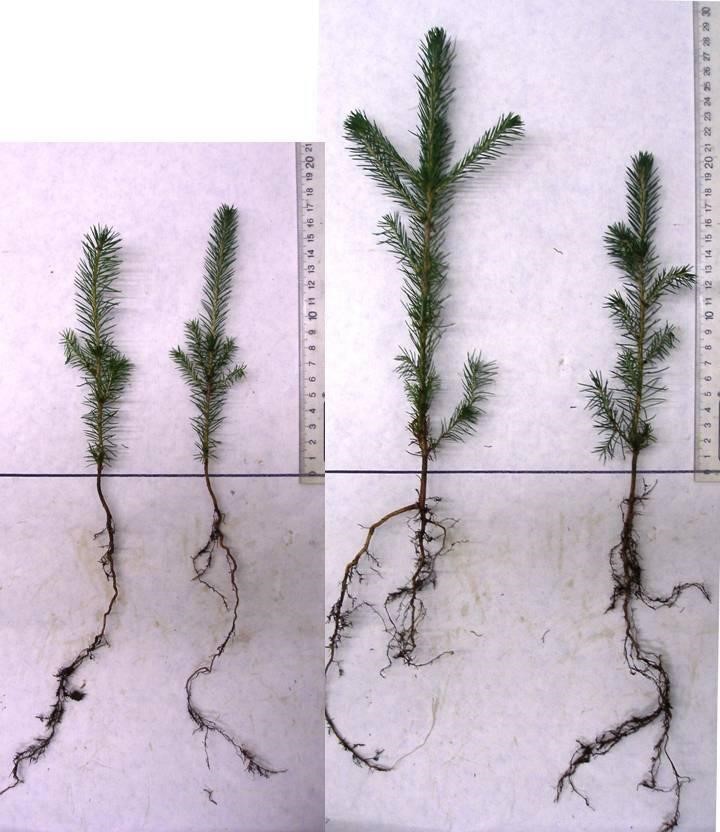THE EFFECTIVENESS OF NATURAL GROWTH STIMULANTS IN THE CULTIVATION OF SEEDLINGS OF PICEA OBOVATA LEDEB.
UDC 630*173/174: 631.811.98
Abstract
Picea obovata Ledeb. is a slow-growing in the early stages of growth type of coniferous trees. The use of growth stimulants in the cultivation of spruce seedlings can accelerate the production of standard planting material. The paper presents the results of research of plant growth regulators influence on spruce seedlings within three years of cultivation in forest nursery conditions. Before sowing seeds of spruce soak in solutions of biological-active preparations Verva and Verva-spruce, obtaining from Abies and Picea wood greenery extracts. The plants growth regulator Verva from Abies needles (operating substance – triterpenic acids) is applied in plant growing at cultivation agricultural and commercial crops. Operating substance of a preparation Verva-spruce used for protection of agricultural plants from diseases, are phenolic compounds of Picea wood greenery possessing fungicidal and insecticidal activity.
It is established that spruce seedlings processed before sowing by bio-preparation had higher parameters of growth (seedling height, diameter of seedling tree at root neck) in comparison with control plants within three years of cultivation in conditions of forest nursery. Three-year spruce seedlings which have been grown up with use of growth stimulators Verva and Verva-spruce exceeded control on 20–30% on height and on 19–20% on seedling tree thickness.
Bio-preparations Verva and Verva-spruce can be recommended for application in forest nurseries as effective growth stimulators at cultivation of Siberian spruce landing material.
Downloads
Metrics
References
Gosudarstvennyy katalog pestitsidov i agrokhimikatov, razreshennykh k primeneniyu na territorii Rossiyskoy Feder-atsii 2019. [State catalogue of pesticides and agrochemicals permitted for use on the territory of the Russian Federation 2019]. URL: www.agroxxi.ru/goshandbook. (in Russ.).
Bulgari R., Cocetta G., Trivellini A., Vernieri P., Ferrante A. Biol Agric Hortic., 2015, vol. 31(1), pp. 1–17. DOI: 10.1080/01448765.2014.964649.
Calvo P., Nelson L., Kloepper J.W. Plant Soil, 2014, vol. 383, pp. 3–41. DOI: 10.1007/s11104-014-2131-8.
Canellas L.P., Olivares F.L., Aguiar N.O., Jones D.L., Nebbioso A., Mazzei P., Piccolo A. Sci. Hortic., 2015, vol. 196, pp. 15–27. DOI: 10.1016/j.scienta.2015.09.013.
Khan W., Rayirath U.P., Subramanian S., Jithesh M.N., Rayorath P., Hodges D.M., Critchley A.T., Craigie J.S., Nor-rie J., Prithiviraj B. J. Plant Growth Regul., 2009, vol. 28(4), pp. 386–399. DOI: 10.1007/s00344-009-9103-x.
McCarthy N., Bentsen N.S., Willoughby I., Balandier P. Eur. J. Forest Res., 2011, vol. 130, pp. 7–16. DOI: 10.1007/s10342-010-0429-5.
Landis T.D. National proceedings: forest and conservation nursery associations - 2010. Proc. RMRS-P-65. Fort Col-lins, CO: USDA Forest Service, Rocky Mountain Research Station, pp. 61–66.
Howe A.A., Landhäusser S.M., Burney O.T., Long J.N., Mock K.E. New For., 2020, vol. 51, pp. 367–378. DOI: 10.1007/s11056-019-09727-8.
Alfredsen G., Solheim H., Slimestad R. Eur. J. Forest Res., 2008, vol. 127, pp. 387–393. DOI: 10.1007/s10342-008-0222-x.
Malykhin E.V., Vaganova T.A., Kukina T.P., Popov S.A., Chibiryaev A.M. Chemistry for Sustainable Development, 2007, vol. 15, pp. 287–303.
Saskevich P.A., Mirenkov Yu.A., Kazharski V.R., Duktov V.P., Kozlov S.N., Vlasov A.G., Gurikova E.I. Rek-omendacii proizvodstvu dlya sel'skohozyajstvennyh organizacij. [Recommendations for production for agricultural or-ganizations]. Gorki, 2006, 28 p. (in Russ.).
Nagel R., Berasategui A., Paetz C., Gershenzon J., Schmidt A. Plant Physiol., 2014, vol. 164, pp. 555–569. DOI: 10.1104/pp.113.228940.
Khurshkaynen T.V., Kutchin A.V. Izvestiya Komi nauchnogo tsentra UrO RAN, 2011, no.1, pp. 17–23. (in Russ.).
Tulinov A.G. Zashchita i karantin rasteniy, 2017, no. 2, pp. 41–42. (in Russ.).
Larin V.B. Kul'tury yeli i kedra sibirskogo na severo-vostoke yevropeyskoy chasti SSSR [Cultures of spruce and Siberi-an pine in the northeast of the European part of the USSR]. Leningrad, 1980, 224 p. (in Russ.).
Kavosi M.R. Lesnoy vestnik, 2006, no. 2, pp. 161–166. (in Russ.).
Pentelkina N.V. Aktual'nyye problemy lesnogo kompleksa, 2012, no. 31, pp. 189–193. (in Russ.).
Kirienko M.A., Goncharova I.A. Sib. J. For., 2018, no. 1, pp. 65–70. DOI: 10.15372/SJFS20180107.
Zubarev A.A., Kargin I.F., Papkov A.N. Kartofel' i ovoshchi, 2012, no. 5, p. 7. (in Russ.).
Andreeva E.M., Stetsenko S.K., Kutchin A.V., Terekhov G.G., Khurshkainen T.V. Lesotekhnicheskiy zhurnal, 2016, no. 3, pp. 10–19. DOI: 12737/21675. (in Russ.).
Khurshkainen T.V., Andreeva E.M., Stetsenko S.K., Terekhov G.G., Kutchin A.V. Khimiya rastitel'nogo syr'ya, 2019, no. 1, pp. 295–300. DOI: 10.14258/jcprm.2019014248. (in Russ.).
Pravila lesovosstanovleniya. [Rules for reforestation]. 2016, no. 375, 146 p. (in Russ.).
Kolesnicov B.P., Zubareva R.S., Smologonov E.P. Lesnyye porody i tipy lesov Sverdlovskoy oblasti: prakticheskoye posobiye [Forest Species and Types of Forest in the Sverdlovsk Region: A Practical Guide]. Sverdlovsk, 1973, 176 p. (in Russ.).
Egorova A.V., Chernobrovkina N.P., Robonen E.V. Khimiya rastitel'nogo syr'ya, 2017, no. 2, pp. 171–180. DOI: 10.14258/jcprm.2017021720. (in Russ.).

Copyright (c) 2021 chemistry of plant raw material

This work is licensed under a Creative Commons Attribution 4.0 International License.

This work is licensed under a Creative Commons Attribution 4.0 International License.
The authors, which are published in this journal, agree to the following conditions:
1. Authors retain the copyright to the work and transfer to the journal the right of the first publication along with the work, at the same time licensing it under the terms of the Creative Commons Attribution License, which allows others to distribute this work with the obligatory indication of the authorship of this work and a link to the original publication in this journal .
2. The authors retain the right to enter into separate, additional contractual agreements for the non-exclusive distribution of the version of the work published by this journal (for example, to place it in the university depository or to publish it in a book), with reference to the original publication in this journal.
3. Authors are allowed to post their work on the Internet (for example, in a university repository or on their personal website) before and during the review process of this journal, as this may lead to a productive discussion, as well as more links to this published work.











